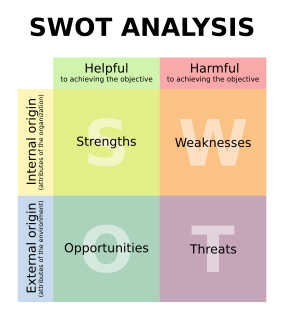In the field of management, strategic management involves the formulation and implementation of the major goals and initiatives taken by an organization's managers on behalf of stakeholders, based on consideration of resources and an assessment of the internal and external environments in which the organization operates. Strategic management provides overall direction to an enterprise and involves specifying the organization's objectives, developing policies and plans to achieve those objectives, and then allocating resources to implement the plans. Academics and practicing managers have developed numerous models and frameworks to assist in strategic decision-making in the context of complex environments and competitive dynamics. Strategic management is not static in nature; the models often include a feedback loop to monitor execution and to inform the next round of planning.
In business, a competitive advantage is the attribute that allows an organization to outperform its competitors.

Porter's Five Forces Framework is a method of analysing the operating environment of a competition of a business. It draws from industrial organization (IO) economics to derive five forces that determine the competitive intensity and, therefore, the attractiveness of an industry in terms of its profitability. An "unattractive" industry is one in which the effect of these five forces reduces overall profitability. The most unattractive industry would be one approaching "pure competition", in which available profits for all firms are driven to normal profit levels. The five-forces perspective is associated with its originator, Michael E. Porter of Harvard University. This framework was first published in Harvard Business Review in 1979.

SWOT analysis is a strategic planning and strategic management technique used to help a person or organization identify strengths, weaknesses, opportunities, and threats related to business competition or project planning. It is sometimes called situational assessment or situational analysis. Additional acronyms using the same components include TOWS and WOTS-UP.
The word ‘dynamics’ appears frequently in discussions and writing about strategy, and is used in two distinct, though equally important senses.
Marketing strategy is a process that can allow an organization to concentrate its limited resources on the greatest opportunities to increase sales and achieve a sustainable competitive advantage.

Michael Eugene Porter is an American academic known for his theories on economics, business strategy, and social causes. He is the Bishop William Lawrence University Professor at Harvard Business School, and he was one of the founders of the consulting firm The Monitor Group and FSG, a social impact consultancy. He is credited for creating Porter's five forces analysis, which is instrumental in business strategy development today.

A strategic partnership is a relationship between two commercial enterprises, usually formalized by one or more business contracts. A strategic partnership will usually fall short of a legal partnership entity, agency, or corporate affiliate relationship. Strategic partnerships can take on various forms from shake hand agreements, contractual cooperation's all the way to equity alliances, either the formation of a joint venture or cross-holdings in each other.
VRIO is a business analysis framework that forms part of a firm's larger strategic scheme. The basic strategic process that any firm begins with a vision statement, and continues on through objectives, internal & external analysis, strategic choices, and strategic implementation. The firm will hope that this process results in a competitive advantage in the marketplace they operate in.
The resource-based view (RBV) is a managerial framework used to determine the strategic resources a firm can exploit to achieve sustainable competitive advantage.
The knowledge-based theory of the firm considers knowledge as the most strategically significant resource of a firm. Its proponents argue that because knowledge-based resources are usually difficult to imitate and socially complex, heterogeneous knowledge bases and capabilities among firms are the major determinants of sustained competitive advantage and superior corporate performance.
The following outline is provided as an overview of and topical guide to marketing:
Within international business, the diamond model, also known as Porter's Diamond or the Porter Diamond Theory of National Advantage, describes a nation's competitive advantage in the international market. In this model, four attributes are taken into consideration: factor conditions, demand conditions, related and supporting industries, and firm strategy, structure, and rivalry. According to Michael Porter, the model's creator, "These determinants create the national environment in which companies are born and learn how to compete."
In organizational theory, dynamic capability is the capability of an organization to purposefully adapt an organization's resource base. The concept was defined by David Teece, Gary Pisano and Amy Shuen, in their 1997 paper Dynamic Capabilities and Strategic Management, as "the firm’s ability to integrate, build, and reconfigure internal and external competences to address rapidly changing environments".
Hypercompetition, a term first coined in business strategy by Richard D’Aveni, describes a dynamic competitive world in which no action or advantage can be sustained for long. Hypercompetition is a key feature of the new global digital economy. Not only is there more competition, there is also tougher and smarter competition. It is a state in which the rate of change in the competitive rules of the game are in such flux that only the most adaptive, fleet, and nimble organizations will survive. Hypercompetitive markets are also characterized by a “quick-strike mentality” to disrupt, neutralize, or moot the competitive advantage of market leaders and important rivals.
Competitive heterogeneity is a concept from strategic management that examines why industries do not converge on one best way of doing things. In the view of strategic management scholars, the microeconomics of production and competition combine to predict that industries will be composed of identical firms offering identical products at identical prices. Deeper analyses of this topic were taken up in industrial organization economics by crossover economics/strategic-management scholars such as Harold Demsetz and Michael Porter. Demsetz argued that better-managed firms would make better products than their competitors. Such firms would translate better products or lower prices into higher levels of demand, which would lead to revenue growth. These firms would then be larger than the more poorly managed competitors.
Capability management is the approach to the management of an organization, typically a business organization or firm, based on the "theory of the firm" as a collection of capabilities that may be exercised to earn revenues in the marketplace and compete with other firms in the industry. "Capability Management" seeks to manage the stock of capabilities within the firm to ensure its position in the industry and its ongoing profitability and survival.
In management, the relational view by Jeffrey H. Dyer and Harbir Singh is a theory for considering networks and dyads of firms as the unit of analysis to explain relational rents, i.e., superior individual firm performance generated within that network/dyad. This view has later been extended by Lavie (2006).
Yves Doz is a French academic. He is a professor of strategic management at INSEAD, where he holds the Solvay Chaired Professorship of Technological Innovation, and is a Fellow of CEDEP. His research interests focus on innovation, the strategy and organization of multinational corporations, strategic alliances, and on how business organizations can develop the capability to adapt quickly to changes in competitive environments. More recently, he has been working with a number of national governments on strategic adaptability and agility. He is the author of numerous books and articles, which include the first comprehensive book on strategic alliances, co-authored with Gary Hamel, and the Multinational Mission, co-authored with CK Prahalad.

Jay B. Barney is an American professor in strategic management at the University of Utah,




